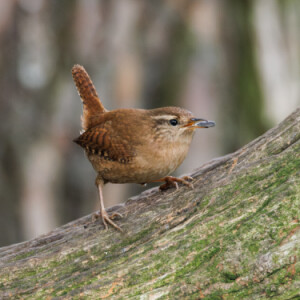Sleight of beak
I don't know how you do prestidigitation without opposable thumbs, but there was a definite hint of a magic trick about this. I had the camera trained and focused on this Wren for several seconds, shooting on burst, during which sequence it barely moved its feet and didn't appear to do more than look down at the crevices in the tree stump - and then, between one frame and the next, it produced a sunflower seed. I almost doubted my own photographic evidence until I saw the next frame (below), which proved it. In the one after that the bird had turned further to its left, preparatory to flying away, but was still clearly clutching the seed.
One of our smallest native birds, according to the Wildlife Trusts the Wren is also the most common, with over eight and a half million breeding territories in the UK. Despite this, and the fact that it can live in a wide range of environments including suburban gardens, farmland, woodland, heaths and moors, it's Amber listed in the December 2021 edition of the UK's Birds of Conservation Concern, suggesting that its continuing success isn't guaranteed.
With a body weight of just 10g Wrens need to eat almost constantly to fuel their metabolism, and spend most of each day searching for food. They primarily eat spiders and insects, especially the larvae of butterflies, moths and beetles, but also the aquatic larvae of caddisflies and hoverflies, which they pluck from shallow water. In autumn and winter when invertebrate prey is scarcer they will take seeds and berries, and will sometimes scavenge underneath garden feeding stations. The biggest threat they face in the UK is cold, with the RSPB estimating a mortality rate of up to 80% in the severest winters, after each of which it takes several years for the population to recover. Though normally territorial throughout the year, in very cold weather Wrens will sometimes come together and roost communally, to help each other conserve body heat.


Comments
Sign in or get an account to comment.


